2022年中考英语专题语法复习课件09非谓语动词(21张PPT)
文档属性
| 名称 | 2022年中考英语专题语法复习课件09非谓语动词(21张PPT) |  | |
| 格式 | pptx | ||
| 文件大小 | 499.0KB | ||
| 资源类型 | 教案 | ||
| 版本资源 | 人教新目标(Go for it)版 | ||
| 科目 | 英语 | ||
| 更新时间 | 2022-03-15 22:32:40 | ||
图片预览

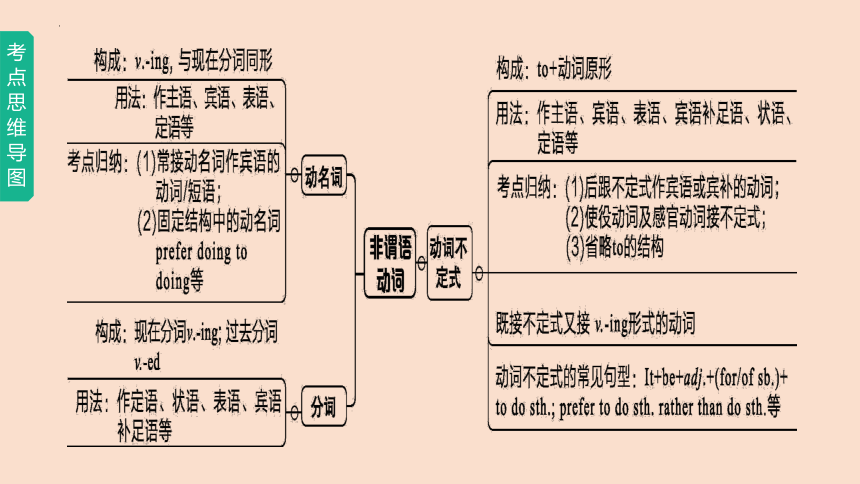



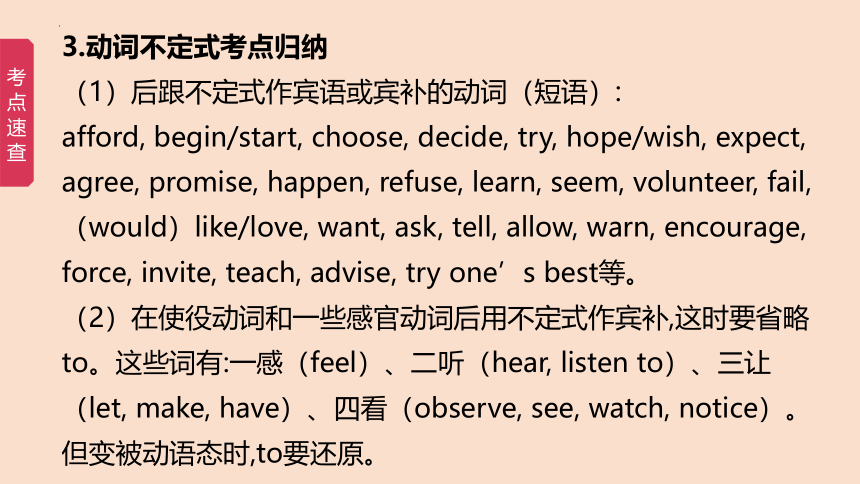
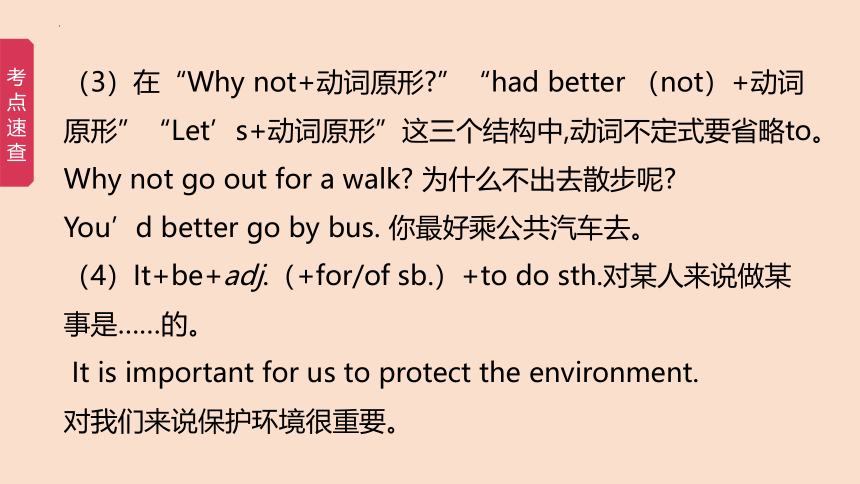
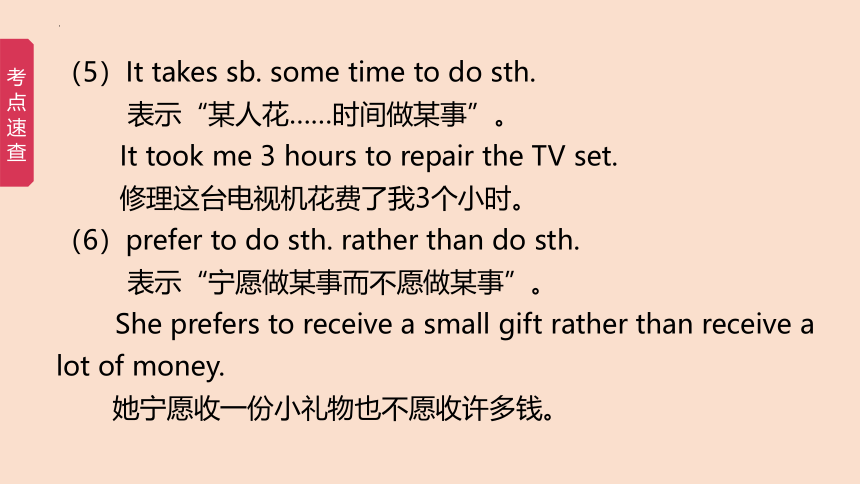
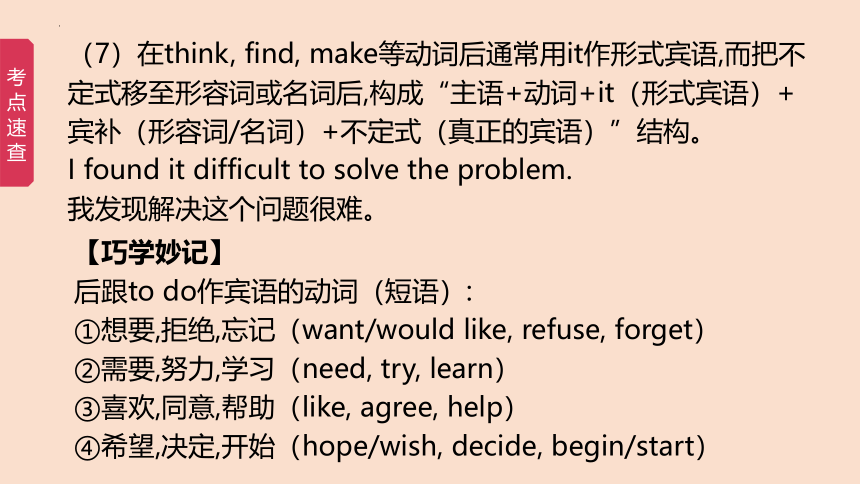
文档简介
(共21张PPT)
语法复习09 非谓语动词
考点思维导图
考点速查
1.动词不定式的构成:
to+动词原形;否定形式:not to+动词原形。
2.动词不定式的用法
考点一
动词不定式
功能 用法
例句
作主语 常用it作形式主语,而将不定式后置。常用句型:It is+adj.+(of/for sb.)to do sth.; It takes sb.+时间段+to do sth. To swim here alone is very dangerous.=It’s very dangerous to swim here alone. 独自在这儿游泳很危险。
作表语 常位于be动词后 My job today is to clean the room.
我今天的工作是打扫房间。
考点速查
(续表)
功能 用法
例句
作宾语 一般只作某些动词的宾语 I decided to go on a trip to Dali.
我决定去大理旅游。
作宾语 补足语 在使役动词make, let, have和感官动词hear, see, watch等后面,省略to Miss Li made us do Exercise One.
李老师让我们做练习一。
作定语 常放在所修饰词的后面作后置定语 Do you have anything to do
你有要做的事吗
考点速查
(续表)
功能 用法
例句
作状语 一般在句中作目的、结果、原因状语 I get up early every morning to catch the early bus. 我每天早晨早起是为了赶早班车。
与疑问词 构成不定 式短语 “疑问词what, how, who, which, when…+to do” 在句中可作主语、表语、宾语等 She really didn’t know what to do next.
她真的不知道下一步该怎么办。
考点速查
3.动词不定式考点归纳
(1)后跟不定式作宾语或宾补的动词(短语):
afford, begin/start, choose, decide, try, hope/wish, expect, agree, promise, happen, refuse, learn, seem, volunteer, fail, (would)like/love, want, ask, tell, allow, warn, encourage, force, invite, teach, advise, try one’s best等。
(2)在使役动词和一些感官动词后用不定式作宾补,这时要省略to。这些词有:一感(feel)、二听(hear, listen to)、三让(let, make, have)、四看(observe, see, watch, notice)。但变被动语态时,to要还原。
考点速查
(3)在“Why not+动词原形 ”“had better (not)+动词原形”“Let’s+动词原形”这三个结构中,动词不定式要省略to。
Why not go out for a walk 为什么不出去散步呢
You’d better go by bus. 你最好乘公共汽车去。
(4)It+be+adj.(+for/of sb.)+to do sth.对某人来说做某事是……的。
It is important for us to protect the environment.
对我们来说保护环境很重要。
考点速查
(5)It takes sb. some time to do sth.
表示“某人花……时间做某事”。
It took me 3 hours to repair the TV set.
修理这台电视机花费了我3个小时。
(6)prefer to do sth. rather than do sth.
表示“宁愿做某事而不愿做某事”。
She prefers to receive a small gift rather than receive a lot of money.
她宁愿收一份小礼物也不愿收许多钱。
考点速查
(7)在think, find, make等动词后通常用it作形式宾语,而把不定式移至形容词或名词后,构成“主语+动词+it(形式宾语)+宾补(形容词/名词)+不定式(真正的宾语)”结构。
I found it difficult to solve the problem.
我发现解决这个问题很难。
【巧学妙记】
后跟to do作宾语的动词(短语):
①想要,拒绝,忘记(want/would like, refuse, forget)
②需要,努力,学习(need, try, learn)
③喜欢,同意,帮助(like, agree, help)
④希望,决定,开始(hope/wish, decide, begin/start)
考点速查
4.既能接动词不定式又能接动词-ing形式的动词
(1)既能接动词不定式又能接动词-ing形式作宾语,且意义差别不大的动词有:like, love, hate, begin, start等。
Do you like playing/to play football 你喜欢踢足球吗
(2)既能接动词不定式又能接动词-ing形式作宾语,但意义差别很大的动词(短语)有:
考点速查
考点速查
He stopped watching TV and began to read English.
他停止看电视,开始读英语。
He watched TV for an hour. At 8:00 he stopped to do his homework.
他看了一个小时的电视。八点钟他停下(看电视)去做作业。
考点速查
考点二
动名词
1.动名词的构成:动词原形+-ing,与现在分词同形。动名词既有动词的性质又有名词的性质。
2.动名词的用法
功能 用法
例句
作主语 单个动名词作主语,谓语动词用单数形式 Playing computer games too much is bad for your eyes. 玩太多电脑游戏对你的眼睛有害。
作宾语 动名词作宾语表示一般的习惯性行为或经常性动作 My sister likes dancing very much.
我妹妹非常喜欢跳舞。
动名词作介词的宾语 I’m looking forward to going home.
我期待回家。
考点速查
(续表)
功能 用法
例句
作表语 多数情况下,动名词作表语可转化为作主语 Your task is cleaning the windows.
你的任务是擦窗户。
作定语 位于所修饰词之前,只表明所修饰词的用途等 My mother bought a washing machine last Sunday. 我妈妈上周日买了一台洗衣机。
考点速查
3.动名词考点归纳
(1)常接动名词作宾语的动词有:enjoy, finish, consider, miss, keep, mind, practice, suggest, avoid, prefer, need/require/want等
(2)常接动名词作宾语的短语有:be busy, feel like, give up, can’t help, be used to, be worth, be afraid of, be proud of, be interested in, can’t stop, keep/stop…from, look forward to, put off, have fun, have difficulty/problem/trouble (in)等
考点速查
(3)固定结构中的动名词
①“There be+名词(短语)+动名词”意为“某处有某人或某物正在干某事”。
There are some people playing soccer in the park.
一些人正在公园里踢足球。
②prefer doing to doing意为“喜欢……胜过……”。
Tom prefers dancing to singing.
比起唱歌,汤姆更喜欢跳舞。
考点速查
③“No+Doing sth.”意为“禁止/不准干某事”。
No Parking.不准停车。
④“sb. spend some time/money (in)doing sth.”意为“某人花费一些时间/金钱干某事”。
Our school has spent thousands of pounds updating the computer systems.
我们学校花了数千英镑更新计算机系统。
考点速查
⑤thank sb. for doing sth.意为“因干了某事而感谢某人”。
Thank you for helping me.谢谢你帮助了我。
⑥“Would/Do you mind doing sth. ”意为“你介意做某事吗 ”
Would you mind turning on the electric fan
你介意打开电风扇吗
【巧学妙记】
后接动名词作宾语的词(短语):
①完成实践值得忙(finish, practice, be worth, be busy)
②继续习惯别放弃(keep on, be used to, give up)
③考虑建议不禁想(consider, suggest, can’t help, feel like)
④喜欢思念要介意(enjoy, miss, mind)
考点速查
考点三
分词
1.构成
(1)现在分词:v.-ing形式,表示动作正在发生,表主动意义。
(2)过去分词:v.-ed,表示动作已经完成,含有被动意义。
2.用法
(1)作定语
①单个分词作定语常位于所修饰的词前
②分词短语作定语常位于所修饰的词后
The soldier rushed into the burning house.
那个士兵冲进了着火的房子。
Do you know the boy called Yang Lin
你认识那个叫杨林的男孩吗
考点速查
(2)作状语
现在分词作伴随状语时,其逻辑主语就是句子的主语
Laughing and talking, they went into the room.
他们有说有笑地走进了房间。
(3)作表语
①现在分词表示主语的性质、特征等
②过去分词表示某种状态
The book is very interesting. I’m interested in it.
这本书很有趣。我对它感兴趣。
考点速查
(4)作宾语补足语
分词作宾语补足语时,常用于感官动词和使役动词后
①宾语与宾补之间为主动关系或表示动作正在进行用现在分词
②宾语与宾补之间为被动关系或表示动作已经完成用过去分词
I heard a girl singing in the next room.
我听见有个女孩正在隔壁房间唱歌。
How beautiful! I want to have some photos taken.
太美了!我想拍几张照片。
语法复习09 非谓语动词
考点思维导图
考点速查
1.动词不定式的构成:
to+动词原形;否定形式:not to+动词原形。
2.动词不定式的用法
考点一
动词不定式
功能 用法
例句
作主语 常用it作形式主语,而将不定式后置。常用句型:It is+adj.+(of/for sb.)to do sth.; It takes sb.+时间段+to do sth. To swim here alone is very dangerous.=It’s very dangerous to swim here alone. 独自在这儿游泳很危险。
作表语 常位于be动词后 My job today is to clean the room.
我今天的工作是打扫房间。
考点速查
(续表)
功能 用法
例句
作宾语 一般只作某些动词的宾语 I decided to go on a trip to Dali.
我决定去大理旅游。
作宾语 补足语 在使役动词make, let, have和感官动词hear, see, watch等后面,省略to Miss Li made us do Exercise One.
李老师让我们做练习一。
作定语 常放在所修饰词的后面作后置定语 Do you have anything to do
你有要做的事吗
考点速查
(续表)
功能 用法
例句
作状语 一般在句中作目的、结果、原因状语 I get up early every morning to catch the early bus. 我每天早晨早起是为了赶早班车。
与疑问词 构成不定 式短语 “疑问词what, how, who, which, when…+to do” 在句中可作主语、表语、宾语等 She really didn’t know what to do next.
她真的不知道下一步该怎么办。
考点速查
3.动词不定式考点归纳
(1)后跟不定式作宾语或宾补的动词(短语):
afford, begin/start, choose, decide, try, hope/wish, expect, agree, promise, happen, refuse, learn, seem, volunteer, fail, (would)like/love, want, ask, tell, allow, warn, encourage, force, invite, teach, advise, try one’s best等。
(2)在使役动词和一些感官动词后用不定式作宾补,这时要省略to。这些词有:一感(feel)、二听(hear, listen to)、三让(let, make, have)、四看(observe, see, watch, notice)。但变被动语态时,to要还原。
考点速查
(3)在“Why not+动词原形 ”“had better (not)+动词原形”“Let’s+动词原形”这三个结构中,动词不定式要省略to。
Why not go out for a walk 为什么不出去散步呢
You’d better go by bus. 你最好乘公共汽车去。
(4)It+be+adj.(+for/of sb.)+to do sth.对某人来说做某事是……的。
It is important for us to protect the environment.
对我们来说保护环境很重要。
考点速查
(5)It takes sb. some time to do sth.
表示“某人花……时间做某事”。
It took me 3 hours to repair the TV set.
修理这台电视机花费了我3个小时。
(6)prefer to do sth. rather than do sth.
表示“宁愿做某事而不愿做某事”。
She prefers to receive a small gift rather than receive a lot of money.
她宁愿收一份小礼物也不愿收许多钱。
考点速查
(7)在think, find, make等动词后通常用it作形式宾语,而把不定式移至形容词或名词后,构成“主语+动词+it(形式宾语)+宾补(形容词/名词)+不定式(真正的宾语)”结构。
I found it difficult to solve the problem.
我发现解决这个问题很难。
【巧学妙记】
后跟to do作宾语的动词(短语):
①想要,拒绝,忘记(want/would like, refuse, forget)
②需要,努力,学习(need, try, learn)
③喜欢,同意,帮助(like, agree, help)
④希望,决定,开始(hope/wish, decide, begin/start)
考点速查
4.既能接动词不定式又能接动词-ing形式的动词
(1)既能接动词不定式又能接动词-ing形式作宾语,且意义差别不大的动词有:like, love, hate, begin, start等。
Do you like playing/to play football 你喜欢踢足球吗
(2)既能接动词不定式又能接动词-ing形式作宾语,但意义差别很大的动词(短语)有:
考点速查
考点速查
He stopped watching TV and began to read English.
他停止看电视,开始读英语。
He watched TV for an hour. At 8:00 he stopped to do his homework.
他看了一个小时的电视。八点钟他停下(看电视)去做作业。
考点速查
考点二
动名词
1.动名词的构成:动词原形+-ing,与现在分词同形。动名词既有动词的性质又有名词的性质。
2.动名词的用法
功能 用法
例句
作主语 单个动名词作主语,谓语动词用单数形式 Playing computer games too much is bad for your eyes. 玩太多电脑游戏对你的眼睛有害。
作宾语 动名词作宾语表示一般的习惯性行为或经常性动作 My sister likes dancing very much.
我妹妹非常喜欢跳舞。
动名词作介词的宾语 I’m looking forward to going home.
我期待回家。
考点速查
(续表)
功能 用法
例句
作表语 多数情况下,动名词作表语可转化为作主语 Your task is cleaning the windows.
你的任务是擦窗户。
作定语 位于所修饰词之前,只表明所修饰词的用途等 My mother bought a washing machine last Sunday. 我妈妈上周日买了一台洗衣机。
考点速查
3.动名词考点归纳
(1)常接动名词作宾语的动词有:enjoy, finish, consider, miss, keep, mind, practice, suggest, avoid, prefer, need/require/want等
(2)常接动名词作宾语的短语有:be busy, feel like, give up, can’t help, be used to, be worth, be afraid of, be proud of, be interested in, can’t stop, keep/stop…from, look forward to, put off, have fun, have difficulty/problem/trouble (in)等
考点速查
(3)固定结构中的动名词
①“There be+名词(短语)+动名词”意为“某处有某人或某物正在干某事”。
There are some people playing soccer in the park.
一些人正在公园里踢足球。
②prefer doing to doing意为“喜欢……胜过……”。
Tom prefers dancing to singing.
比起唱歌,汤姆更喜欢跳舞。
考点速查
③“No+Doing sth.”意为“禁止/不准干某事”。
No Parking.不准停车。
④“sb. spend some time/money (in)doing sth.”意为“某人花费一些时间/金钱干某事”。
Our school has spent thousands of pounds updating the computer systems.
我们学校花了数千英镑更新计算机系统。
考点速查
⑤thank sb. for doing sth.意为“因干了某事而感谢某人”。
Thank you for helping me.谢谢你帮助了我。
⑥“Would/Do you mind doing sth. ”意为“你介意做某事吗 ”
Would you mind turning on the electric fan
你介意打开电风扇吗
【巧学妙记】
后接动名词作宾语的词(短语):
①完成实践值得忙(finish, practice, be worth, be busy)
②继续习惯别放弃(keep on, be used to, give up)
③考虑建议不禁想(consider, suggest, can’t help, feel like)
④喜欢思念要介意(enjoy, miss, mind)
考点速查
考点三
分词
1.构成
(1)现在分词:v.-ing形式,表示动作正在发生,表主动意义。
(2)过去分词:v.-ed,表示动作已经完成,含有被动意义。
2.用法
(1)作定语
①单个分词作定语常位于所修饰的词前
②分词短语作定语常位于所修饰的词后
The soldier rushed into the burning house.
那个士兵冲进了着火的房子。
Do you know the boy called Yang Lin
你认识那个叫杨林的男孩吗
考点速查
(2)作状语
现在分词作伴随状语时,其逻辑主语就是句子的主语
Laughing and talking, they went into the room.
他们有说有笑地走进了房间。
(3)作表语
①现在分词表示主语的性质、特征等
②过去分词表示某种状态
The book is very interesting. I’m interested in it.
这本书很有趣。我对它感兴趣。
考点速查
(4)作宾语补足语
分词作宾语补足语时,常用于感官动词和使役动词后
①宾语与宾补之间为主动关系或表示动作正在进行用现在分词
②宾语与宾补之间为被动关系或表示动作已经完成用过去分词
I heard a girl singing in the next room.
我听见有个女孩正在隔壁房间唱歌。
How beautiful! I want to have some photos taken.
太美了!我想拍几张照片。
同课章节目录
- 词法
- 名词
- 动词和动词短语
- 动词语态
- 动词时态
- 助动词和情态动词
- 非谓语动词
- 冠词
- 代词
- 数词和量词
- 形容词副词及其比较等级
- 介词和介词短语
- 连词和感叹词
- 构词法
- 相似、相近词比较
- 句法
- 陈述句
- 一般疑问句和否定疑问句
- 特殊疑问句及选择疑问句
- 反意疑问句
- 存在句(There be句型)
- 宾语从句
- 定语从句
- 状语从句
- 主谓一致问题
- 简单句
- 并列句
- 复合句
- 主谓一致
- 主、表语从句
- 名词性从句
- 直接引语和间接引语
- 虚拟语气
- 感叹句
- 强调句
- 倒装句
- 祈使句
- 句子的成分
- 句子的分类
- 题型专区
- 单项选择部分
- 易错题
- 完形填空
- 阅读理解
- 词汇练习
- 听说训练
- 句型转换
- 补全对话
- 短文改错
- 翻译
- 书面表达
- 任务型阅读
- 语法填空
- 其他资料
